�
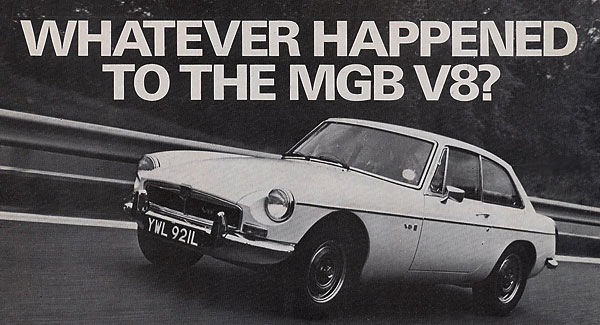
�
The cumbersome MGC was a flop but the MGB V8 couldn't fail with its lightweight
�
Rover engine. So why were so few made? Why is it not made now? Chris Harvey
�
looks at the fate of MG's cut-price supercar that is now valued as an appreciating
�
asset as well as an appealing road burner.
�
as published in British V8 Newsletter, Volume XV Issue 3, December 2007�
�
Re-printed unedited by exclusive written permission of "Classic and Sportscar".
�
(This article originally appeared in the June 1979 issue of "Old Motor" magazine.
�
Sometime between 1979 and 1983, Old Motor magazine was re-launched as Classic and Sportscar.) �
�
� You know what they say about MGs: they are the most popular, loveable sports cars in � the world, but they don't go fast enough. You can just about top the ton in the current � antique, the MGB, if you live on the right side of the pond; if you are unfortunate enough � to be an American enthusiast, you'll be lucky to squeeze 90 out of your emission-strangled � B. Why are they so popular, then? Because they are the last rip-roaring hair-in-the-air,� well-nigh indestructible sports car in full-scale production. The B might ride like the � rocky road to Dublin but it will cling on when most of the rest have slid into oblivion. � All it needs is a bit of oomph, so it is amazing that Abingdon's attempts at producing a � really quick car have met with commercial disaster. Both the MGC (MGB plus two cylinders) � and the MGB GT V8 (MGB plus four) were good for more than 120mph, but the C handled like a � barge because the engine was too heavy and the V8 was killed by politics and the totally � false impression that it gobbled fuel in the height of an energy crisis. In fact they made � only 2591 V8s; with the exception of the Boy's Own Paper hot rod, the MGA Twin Cam (of � which 2111 were built) it was the smallest production run from Abingdon since the war. � As the V8 was also the fastest production MG, and one of the best handling, it immediately � became a collector's piece as soon as they stopped making them in July 1976. Seems like we � never know how good a car is until it's gone.�
��
You'll have to pay up to £4000 for a really good new one now, the price of a new �
MGB and double that of the equivalent four-cylinder made at the same time. Nearly half �
(1072) of the V8s made had a chrome front - a body that looked exactly like that of the �
equivalent MGB GT; the rest were the rubber bumper model made from October 1974 to meet �
short-sighted U.S. Federal safety regulations. These later V8's also suffered from a spot �
of penny-pinching in that British Leyland omitted to fit anti-roll bars front and rear to �
make up for the deterioration in handling brought about by raising the ride height to help �
meet the new bumper regulations. Actually, all the production MGB V8s had a slightly higher �
ride height because they had fatter 175-section tyre and alloy road wheels against the �
four-cylinder's 165 x 14 wires or steel wheels. Apart from a modest sprinkling of V8 �
badges, their wheels, and slightly higher ride height - giving a more muscular appearance �
- were the chief way of telling them apart from the four-cylinder cars, apart from driving �
them, of course.�
�
The difference in performance imparted by the V8's all-alloy 3528cc Rover engine was �
fantastic. It was good for 124mph, with a 0-60mph time of 8.6sec and standing quarter mile �
in 16.4sec against the four-cylinder car's 102mph, 13sec and 18.5 (reduced to 96mph, 14.6 �
and 20.2 in 1973 Federal specification). Fuel consumption was very good: 25mpg against 27mpg �
from the four-cylinder. People just assumed that an MGB with a V8 engine was thirstier than �
the lower-powered car and British Leyland did little to quell their fears apart from coughing �
up a generous quota of road test cars for the popular magazines of the day and leaving people �
to find out for themselves. An advertising campaign emphasizing this point would have done �
the world of good for V8 sales, but, then, it was never a popular model in corporate circles. �
�
| �
Enjoying this article? Our magazine is funded through the generous support of sponsors like: � Mantell Motorsport � "Where the Spirit of Driving has a Home!" � (Pete Mantell specializes in Ford-based MGB-V8 conversions/parts and powder coating.) � |
� British Leyland only authorized production in what seems a fit of pique. Down at Abingdon � they had been fiddling about with MGB V8s for years. Designer Syd Enever tried all sorts � of combinations, including Coventry Climax and Daimler engines when Jaguar joined the fold � in 1968. It was obvious that his stiff MGB shell would take a more powerful engine provided � it didn't weigh appreciably more than the existing B-series unit's 358lb. The MGC of 1967 � had used a modified MGB shell and proved to be a disaster when BMC's redesigned C series � 2912cc engine tipped the scales at no less than 567lb. "It should have been half a � hundredweight lighter," said John Thornley, the man in charge of MGs at the time. Rover's � magnificent alloy V8 weighed about 320lb. (and slightly more than the B series engine � when equipped with beefed-up ancillaries), but did not come into the reckoning for a � variety reasons in 1967: Rover needed all the engines they could produce and fitting it � to an MGB would have increased the demand considerably. Beside MG and Rover were not yet � in the same commercial group, British Leyland. � �
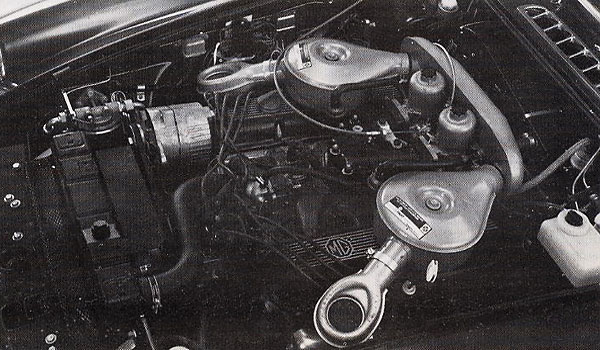
� Rover's ex-Buick light-alloy V8 shoehorned neatly into the MGB's engine bay:
� It weighed 250lb less than the straight-six C and gave more power.
�
�
The history of Rover's wonderfully versatile engine is fascinating. This pushrod unit �
had been developed from a General Motors engine used between 1960 and 1963. The Americans �
stopped production when their thin-wall iron casting techniques improved sufficiently to �
make the lightweight V8 an oddball in their range. It was spotted accidentally by a Rover �
executive and built under license for the company's saloons and later the Range Rover. �
Fitting it to the MGB in 1967 would have involved considerable expenditure in meeting �
anti-emission regulations and could have caused problems with General Motors who did not �
want to see a cheap, and fast, MGB competing with their Stingray, and using one of their �
engines. �
�
(British V8 editor's note: Fitting a discontinued GM engine into MGC wasn't a realistic �
option when the MGC was being developed. Remarkably, many people fail to note the obvious �
American alternative: the small-block Ford V8 engine that was already being used in �
British-made Sunbeam Tigers. The timing could have worked out so well: with purchase of �
Sunbeam by Chrysler, Ford had reason to look for another customer. The Ford 289 V8 in �
Mark-2 Tigers was 150lbs. lighter than an MGC six, yet it produced far more power and �
torque. Ford had to comply with the same anti-emission regulations mentioned above, so �
MG's engineering costs would have been largely mitigated. The MGC chassis provided a �
stronger, stiffer platform than the Sunbeam Tiger, superior handling, and a GT bodyshell �
option. MG's much larger dealer network, compared to Sunbeam, would have made an MGC with �
factory-installed Ford V8 a great success.)�
�
However, during 1970, when MGC production had been abandoned, a garage proprietor from �
Kent, Ken Costello, who had raced MGBs, started experimenting with fitting the Rover V8 �
engine to the cars of customers who wanted more performance without the handling problems �
of the MGC. It was an extraordinarily attractive unit, producing 185bhp at 5000rpm in the �
10.5:1 compression ratio form used in Rover saloons and 137bhp in the 8.25:1 Range Rover �
form. The torque, 226 lb. ft. was massive and proved to be something of an Achilles heel �
to the Costello V8s when mated with the standard MGB all-synchromesh gearbox it was rather �
too much. However, other advantages of the installation tended to blind people to this �
problem; a variety of stiffer rear springs were available to provide tramp-free take-off �
and the performance was phenomenal - 130mph, 0-60mph in 7.8sec. and the standing quarter �
mile in 15.8sec with the heavier GT version. This weighed 20.5cwt with a fiberglass bonnet �
reshaped to clear the Rover engine's twin SU carburetters. Roadsters weighed around 1cwt �
less and were slightly faster. �
�
There was one additional problem with the roadster in that its shell was not really stiff �
enough to take all that torque. These bespoke Costello cars retailed at around £2600 �
in 1972 with the larger (9.5 in.) MGC clutch and higher rear axle ratio (3.07 against 3.9:1); �
more than double the price of a standard MGB GT at the time. Nevertheless, they received �
considerable publicity and demand was quite high. After the debacles of the MGC, British �
Leyland were stung into action. They stopped supplying new engines to Ken Costello and �
started work on their own MGB V8. Costello soldiered on with exchange units and the odd �
errant Buick, but there was no hope of him setting up a production line. �
�
Enjoying this article? Our magazine is funded through the generous support of readers like you!
�
To contribute to our operating budget, please click here and follow the instructions.
�
(Suggested contribution is twenty bucks per year. Feel free to give more!)�
�
Meanwhile Abingdon ran up their first MGB with Rover power in December 1972; it was an �
extraordinarily neat conversion of the GT shell using the Range Rover version of the V8 �
and SU carburetters as they considered that its 137bhp and 193lb. ft. of torque were �
quite sufficient for the gearbox and rear springs, which were stiffened in any case. �
A special inlet manifold was used so that the carburetters could be squeezed under a �
standard bonnet (British Leyland had come in for considerable criticism from America �
for the bulges on the MGC bonnet) and a higher ratio overdrive gearbox with 3.07:1 rear �
axle. Fuel consumption was thus improved to around 25 mpg against Costello's lower-geared �
cars, which returned about 18mpg. �
�
Some slight modifications were needed to the cars' shells (mostly rounding off corners �
in the engine compartment) and it was decided to standardize this with the four-cylinder �
machine. Thus, all the MGBs from mid-1973 when V8 production got under way were built �
with this new shell. Only the GT version was built by the factory, however, who were �
worried about the roadster's rigidity. It was intended to export the MG V8 to America �
(where the vast majority of MGBs were sent) and seven left-hand-drive cars were built �
in the development department at Abingdon alongside ten right-hand-drive ones in �
January and February 1973. However, the same situation that had gone against the MG V8 �
in 1967 still applied and there was the problem that there was hardly sufficient room �
under the bonnet for America's increasingly bulky emission equipment. Eventually, the �
MGB GT V8 was announced in right-hand-drive form only in August 1973. Two of the �
left-hand-drive cars were sent to the New York Motor Show and were returned to Abingdon �
later to join the other five, which were retained until 1974 and 1975. Six were then �
sold to European customers and the other went to British rallyman Michael Pearson, who �
campaigned it with considerable success. Swiss MG enthusiast Thomas Studer bought one �
of the other left-hand-drive cars and races that on the track.�
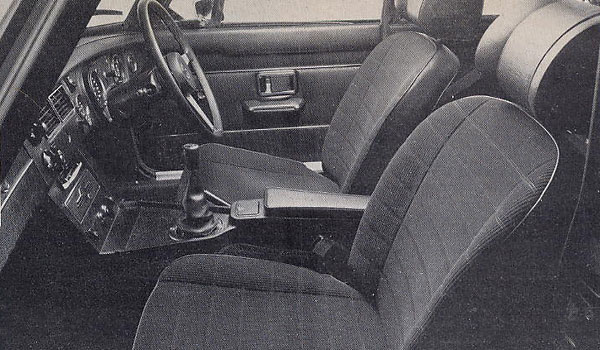
� Interior of the first '73 MGB V8 - simple to the point of being austere,
� but comfortable and cosy with it. Seat had plaid cloth upholstery.
�
�
Unfortunately, just as the MGB GT V8 was launched, Britain was about to lurch into a �
deepening energy crisis and this, with the difficulties in building enough V8 engines, �
kept production down. The price didn't help either: £2294 in the United Kingdom �
against £1547 for a four-cylinder MGB and only £1824 for the nearest �
competitor, the Ford Capri 3000 GXL. The V8 could have been offered for £1800-1900, �
but British Leyland figured that Costello's had sold for much more and there �
was a market for a limited amount at the higher price. This was not to prove the case, �
however, and production petered out (1069 cars built in 1973, 854 in 1974, 489 in 1975 �
and only 176 in 1976) before the V8 was no more. One more factor that went against it �
was that British Leyland decided to drop the MGB GT in America in 1975 to give their �
new hope, the Triumph TR7, a clear run. �
�
As with any MGB, you have to check for rust in the sills and wings of an elderly example �
(this can be quite easily prevented by modern rust-proofing agents); with the V8s be �
especially wary of a noisy gearbox (even in its 137bhp standard form, the box was on �
the limit of its capacity), and anything other than a very smooth engine. The switches �
on the V8's twin electric fans are notoriously unreliable and can lead to unexpected �
overheating with subsequent engine trouble. �
�
Such is the interest in the renaissance of the MGB V8 that rumour has it that British �
Leyland are about to make more. This has been hotly denied by official sources, who �
make the point that the four-cylinder cars are still selling so well (and pass the �
half-million production figure this year) that they have their work cut out producing �
enough of them!�
Chatham's open V8
��
After the demise of the production cars, there was still a certain demand for the MG �
V8, and Costello continued to convert the odd car. Another garage proprietor and �
racing driver, John Chatham wondered what he could do to alleviate the situation. �
What the enthusiasts really wanted, he reasoned, was an open MG with V8 performance. �
�
With the considerable experience of running and building Big Healeys and ex-works �
MGCs behind him, Chatham decided to use the MGC shell for his prototype. This was �
much stiffer than that of the MGB roadster and he had lots of ex-works parts in any �
case. He then obtained a modified V8 engine giving around 200bhp fitted with a �
Costello Weber conversion, and mated it to an MGC gearbox. To get over the MGB V8's �
gearbox problem, he fitted works straight-cut gear clusters and competition overdrive �
on third and fourth with a 3.7:1 limited slip rear axle, 14in. x 7in. Minilite wheels �
and low-profile tyres. Suspension and braking were uprated to competition standards �
and the performance was shattering. �
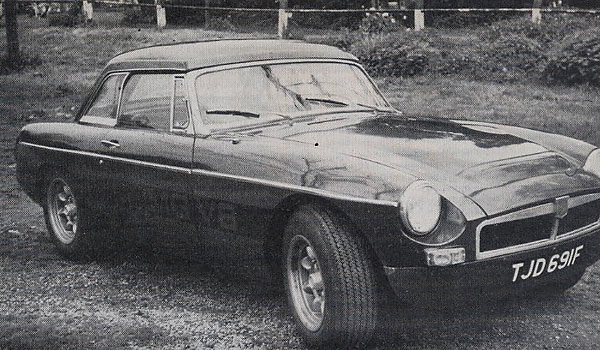
�
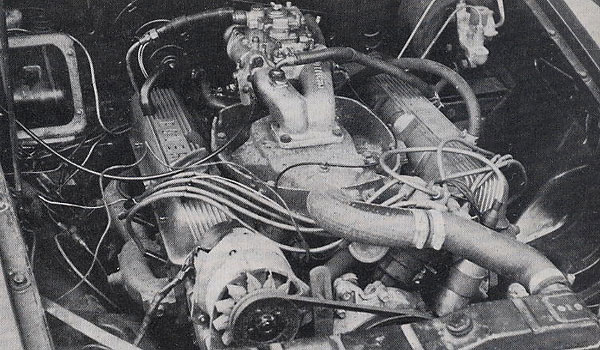
� Chris Harvey's Chatham-converted V8-engined MGC roadster on Minilite wheels and 7in.
� tyres. With modified 200bhp engine, the car will sprint to 60mph in under 6 seconds.
�
�
When I first tried the car soon after it was completed in Bristol in February 1978 �
it recorded a tyre-smoking 5.8sec 0-60mph time with an unmentionable top speed! Like �
all MG V8s, its 50/50 weight distribution gave it dream-like handling and it took no �
sales talk from Chatham for me to buy the car. In 35,000 miles since then it still �
retains the V8's turbine-like power and has shown me why these machines are sought �
so avidly be collectors. �
�
You can still buy a new MGB GT V8. After converting a number of second hand cars for �
customers, Chatham built his first all-new V8 in January. Using a Rover SD1 engine �
and five-speed gearbox with Triumph TR7 C8 Offenhauser manifold and Holley four-choke �
carburetter, plus Minilite wheels, this machine cost £8200, less the value of �
the new four-cylinder engine, gearbox, wheels and tyres removed. �
�
� BritishV8 Magazine has assembled the largest, most authoritative collection of MG � "MGB GT V8" information you'll find anywhere. Check it out! � Access our � MGB GT V8 article index by clicking here. �
�
